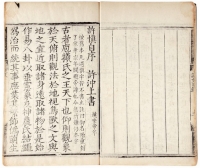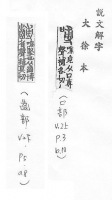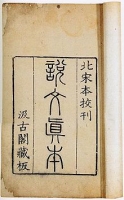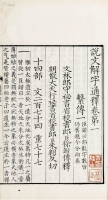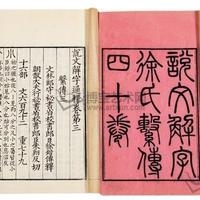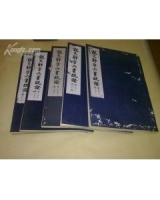序
古者庖羲氏之王天下也,仰則觀象於天,俯則觀法於地,視鳥獸之文與地之宜,近取諸身,遠取諸物;於是始作《易》八卦,以垂憲象。及神農氏,結繩為治,而統其事。庶業其繁,飾偽萌生。黃帝史官倉頡,見鳥獸蹄迒之跡,知分理之可相別異也,初造書契。百工以乂,萬品以察,蓋取諸夬。“夬,揚於王庭”,言文者,宣教明化於王者朝庭,“君子所以施祿及下,居德則忌”也。
倉頡之初作書也,蓋依類象形,故謂之文。其後形聲相益,即謂之字。文者,物象之本;字者,言孳乳而寖多也。著於竹帛謂之書。書者,如也。以迄五帝三王之世,改易殊體,封於泰山者七十有二代,靡有同焉。
《周禮》:八歲入小學,保氏教國子,先以六書。一曰指事。指事者,視而可識,察而見意,“上、下”是也。二曰象形。象形者,畫成其物,隨體詰詘,“日、月”是也。三曰形聲。形聲者,以事為名,取譬相成,“江、河”是也。四曰會意。會意者,比類合誼,以見指撝,“武、信”是也。五曰轉注。轉注者,建類一首,同意相受,“考、老”是也。六曰假借。假借者,本無其事,依聲託事,“令、長”是也。
及宣王太史籀,著大篆十五篇,與古文或異。至孔子書六經,左丘明述春秋傳,皆以古文,厥意可得而說也。
其後諸侯力政,不統於王。惡禮樂之害己,而皆去其典籍。分為七國,田疇異畝,車涂異軌,律令異法,衣冠異制,言語異聲,文字異形。秦始皇帝初兼天下,丞相李斯乃奏同之,罷其不與秦文合者。斯作《倉頡篇》。中車府令趙高作《爰歷篇》。大史令胡毋敬作《博學篇》。皆取《史籀》大篆,或頗省改,所謂小篆也。
是時,秦燒滅經書,滌除舊典。大發吏卒,興戍役。官獄職務繁,初有隸書,以趣約易,而古文由此絕矣。自爾秦書有八體:一曰大篆,二曰小篆,三曰刻符,四曰蟲書,五曰摹印,六曰署書,七曰殳書,八曰隸書。
漢興有草書。尉律:學僮十七以上始試。諷籀書九千字,乃得為史。又以八體試之。郡移太史並課。最者,以為尚書史。書或不正,輒舉劾之。今雖有尉律,不課,小學不修,莫達其說久矣。
孝宣皇帝時,召通《倉頡》讀者,張敞從受之。涼州刺史杜業,沛人爰禮,講學大夫秦近,亦能言之。孝平皇帝時,徵禮等百餘人,令說文字未央廷中,以禮為小學元士。黃門侍郎揚雄,采以作《訓纂篇》。凡《倉頡》以下十四篇,凡五千三百四十字,群書所載,略存之矣。
及亡新居攝,使大司空甄豐等校文書之部。自以為應制作,頗改定古文。時有六書:一曰古文,孔子壁中書也。二曰奇字,即古文而異也。三曰篆書,即小篆。四曰左書,即秦隸書。秦始皇帝使下杜人程邈所作也。五曰繆篆,所以摹印也。六曰鳥蟲書,所以書幡信也。
壁中書者,魯恭王壞孔子宅,而得《禮記》、《尚書》、《春秋》、《論語》、《孝經》。又北平侯張蒼獻《春秋左氏傳》。郡國亦往往於山川得鼎彝,其銘即前代之古文,皆自相似。雖叵復見遠流,其詳可得略說也。
而世人大共非訾,以為好奇者也,故詭更正文,鄉壁虛造不可知之書,變亂常行,以耀於世。諸生競逐說字,解經誼,稱秦之隸書為倉頡時書,云:“父子相傳,何得改易!”乃猥曰:“馬頭人為長,人持十為斗,虫者,屈中也。”廷尉說律,至以字斷法:“苛人受錢,苛之字止句也。”若此者甚眾,皆不合孔氏古文,謬於《史籀》。俗儒鄙夫,翫其所習,蔽所希聞。不見通學,未嘗睹字例之條。怪舊埶而善野言,以其所知為秘妙,究洞聖人之微恉。又見《倉頡篇》中“幼子承詔”,因曰:“古帝之所作也,其辭有神僊之術焉。”其迷誤不諭,豈不悖哉!
《書》曰:“予欲觀古人之象。”言必遵修舊文而不穿鑿。孔子曰:“吾猶及史之闕文,今亡矣夫。”蓋非其不知而不問。人用己私,是非無正,巧說邪辭,使天下學者疑。
蓋文字者,經藝之本,王政之始。前人所以垂後,後人所以識古。故曰:“本立而道生。”知天下之至賾而不可亂也。今敘篆文,合以古籀;博采通人,至於小大;信而有證,稽譔其說。將以理群類,解謬誤,曉學者,達神恉。分別部居,不相雜廁也。萬物咸睹,靡不兼載。厥誼不昭,爰明以喻。其稱《易》孟氏、《書》孔氏、《詩》毛氏、《禮》周官、《春秋》左氏、《論語》、《孝經》,皆古文也。其於所不知,蓋闕如也。
古者庖羲氏之王天下也,仰則觀象於天,俯則觀法於地,視鳥獸之文與地之宜,近取諸身,遠取諸物;於是始作《易》八卦,以垂憲象。及神農氏,結繩為治,而統其事。庶業其繁,飾偽萌生。黃帝史官倉頡,見鳥獸蹄迒之跡,知分理之可相別異也,初造書契。百工以乂,萬品以察,蓋取諸夬。“夬,揚於王庭”,言文者,宣教明化於王者朝庭,“君子所以施祿及下,居德則忌”也。
倉頡之初作書也,蓋依類象形,故謂之文。其後形聲相益,即謂之字。文者,物象之本;字者,言孳乳而寖多也。著於竹帛謂之書。書者,如也。以迄五帝三王之世,改易殊體,封於泰山者七十有二代,靡有同焉。
《周禮》:八歲入小學,保氏教國子,先以六書。一曰指事。指事者,視而可識,察而見意,“上、下”是也。二曰象形。象形者,畫成其物,隨體詰詘,“日、月”是也。三曰形聲。形聲者,以事為名,取譬相成,“江、河”是也。四曰會意。會意者,比類合誼,以見指撝,“武、信”是也。五曰轉注。轉注者,建類一首,同意相受,“考、老”是也。六曰假借。假借者,本無其事,依聲託事,“令、長”是也。
及宣王太史籀,著大篆十五篇,與古文或異。至孔子書六經,左丘明述春秋傳,皆以古文,厥意可得而說也。
其後諸侯力政,不統於王。惡禮樂之害己,而皆去其典籍。分為七國,田疇異畝,車涂異軌,律令異法,衣冠異制,言語異聲,文字異形。秦始皇帝初兼天下,丞相李斯乃奏同之,罷其不與秦文合者。斯作《倉頡篇》。中車府令趙高作《爰歷篇》。大史令胡毋敬作《博學篇》。皆取《史籀》大篆,或頗省改,所謂小篆也。
是時,秦燒滅經書,滌除舊典。大發吏卒,興戍役。官獄職務繁,初有隸書,以趣約易,而古文由此絕矣。自爾秦書有八體:一曰大篆,二曰小篆,三曰刻符,四曰蟲書,五曰摹印,六曰署書,七曰殳書,八曰隸書。
漢興有草書。尉律:學僮十七以上始試。諷籀書九千字,乃得為史。又以八體試之。郡移太史並課。最者,以為尚書史。書或不正,輒舉劾之。今雖有尉律,不課,小學不修,莫達其說久矣。
孝宣皇帝時,召通《倉頡》讀者,張敞從受之。涼州刺史杜業,沛人爰禮,講學大夫秦近,亦能言之。孝平皇帝時,徵禮等百餘人,令說文字未央廷中,以禮為小學元士。黃門侍郎揚雄,采以作《訓纂篇》。凡《倉頡》以下十四篇,凡五千三百四十字,群書所載,略存之矣。
及亡新居攝,使大司空甄豐等校文書之部。自以為應制作,頗改定古文。時有六書:一曰古文,孔子壁中書也。二曰奇字,即古文而異也。三曰篆書,即小篆。四曰左書,即秦隸書。秦始皇帝使下杜人程邈所作也。五曰繆篆,所以摹印也。六曰鳥蟲書,所以書幡信也。
壁中書者,魯恭王壞孔子宅,而得《禮記》、《尚書》、《春秋》、《論語》、《孝經》。又北平侯張蒼獻《春秋左氏傳》。郡國亦往往於山川得鼎彝,其銘即前代之古文,皆自相似。雖叵復見遠流,其詳可得略說也。
而世人大共非訾,以為好奇者也,故詭更正文,鄉壁虛造不可知之書,變亂常行,以耀於世。諸生競逐說字,解經誼,稱秦之隸書為倉頡時書,云:“父子相傳,何得改易!”乃猥曰:“馬頭人為長,人持十為斗,虫者,屈中也。”廷尉說律,至以字斷法:“苛人受錢,苛之字止句也。”若此者甚眾,皆不合孔氏古文,謬於《史籀》。俗儒鄙夫,翫其所習,蔽所希聞。不見通學,未嘗睹字例之條。怪舊埶而善野言,以其所知為秘妙,究洞聖人之微恉。又見《倉頡篇》中“幼子承詔”,因曰:“古帝之所作也,其辭有神僊之術焉。”其迷誤不諭,豈不悖哉!
《書》曰:“予欲觀古人之象。”言必遵修舊文而不穿鑿。孔子曰:“吾猶及史之闕文,今亡矣夫。”蓋非其不知而不問。人用己私,是非無正,巧說邪辭,使天下學者疑。
蓋文字者,經藝之本,王政之始。前人所以垂後,後人所以識古。故曰:“本立而道生。”知天下之至賾而不可亂也。今敘篆文,合以古籀;博采通人,至於小大;信而有證,稽譔其說。將以理群類,解謬誤,曉學者,達神恉。分別部居,不相雜廁也。萬物咸睹,靡不兼載。厥誼不昭,爰明以喻。其稱《易》孟氏、《書》孔氏、《詩》毛氏、《禮》周官、《春秋》左氏、《論語》、《孝經》,皆古文也。其於所不知,蓋闕如也。
一部
一:惟初太始,道立於一,造分天地,化成萬物。凡一之屬皆从一。
元:始也。从一从兀。
天:顚也。至高無上,从一、大。
丕:大也。从一不聲。
吏:治人者也。从一从史,史亦聲。
丄部
丄:高也。此古文上,指事也。凡丄之屬皆从丄。
帝:諦也。王天下之號也。从丄朿聲。
旁:溥也。从二,闕;方聲。
丅:底也。指事。
示部
示:天垂象,見吉凶,所以示人也。从二。三垂,日月星也。觀乎天文,以察時變。示,神事也。凡示之屬皆从示。
祜:上諱。
禮:履也。所以事神致福也。从示从豊,豊亦聲。
禧:禮吉也。从示喜聲。
禛:以眞受福也。从示眞聲。
祿:福也。从示彔聲。
禠:福也。从示虒聲。
禎:祥也。从示貞聲。
祥:福也。从示羊聲。一云善。
祉:福也。从示止聲。
福:祐也。从示畐聲。
祐:助也。从示右聲。
祺:吉也。从示其聲。
祗:敬也。从示氐聲。
禔:安福也。从示是聲。易曰:“禔旣平。”
神:天神,引出萬物者也。从示、申。
祇:地祇,提出萬物者也。从示氏聲。
祕:神也。从示必聲。
齋:戒,潔也。从示,齊省聲。
禋:潔祀也。一曰精意以享為禋。从示垔聲。
祭:祭祀也。从示,以手持肉。
祀:祭無已也。从示巳聲。
祡:燒祡燓燎以祭天神。从示此聲。虞書曰:“至于岱宗,祡。”
禷:以事類祭天神。从示類聲。
祪:祔、祪,祖也。从示危聲。
祔:後死者合食於先祖。从示付聲。
祖:始廟也。从示且聲。
𥛱:門內祭,先祖所以徬徨。从示彭聲。詩曰:“祝祭于𥛱。”
祰:告祭也。从示从告聲。
祏:宗廟主也。周禮有郊、宗、石室。一曰大夫以石為主。从示从石,石亦聲。
䃾:以豚祠司命。从示比聲。漢律曰:“祠䃾司命。”
祠:春祭曰祠。品物少,多文詞也。从示司聲。仲春之月,祠不用犧牲,用圭璧及皮幣。
礿:夏祭也。从示勺聲。
禘:諦祭也。从示帝聲。周禮曰:“五歲一禘。”
祫:大合祭先祖親疏遠近也。从示、合。周禮曰:“三歲一祫。”
祼:灌祭也。从示果聲。
䄟:數祭也。从示毳聲。讀若舂麥為䄟之䄟。
祝:祭主贊詞者。从示从人口。一曰从兌省。易曰:“兌為口為巫。”。
𥛽:祝𥛽也。从示畱聲。
祓:除惡祭也。从示犮聲。
祈:求福也。从示斤聲。
禱:告事求福也。从示壽聲。
禜:設緜蕝為營,以禳風雨、雪霜、水旱、癘疫於日月星辰山川也。从示,榮省聲。一曰禜、衞,使灾不生。禮記曰:“雩,禜。祭水旱。”
禳:磔禳祀,除癘殃也。古者燧人禜子所造。从示襄聲。
襘:會福祭也。从示从會,會亦聲。周禮曰:“禬之祝號。”
禪:祭天也。从示單聲。
禦:祀也。从示御聲。
䄆:祀也。从示𠯑聲。
禖:祭也。从示某聲。
𥚩:祭具也。从示胥聲。
祳:社肉,盛以蜃,故謂之祳。天子所以親遺同姓。从示辰聲。春秋傳曰:“石尚來歸祳。”
祴:宗廟奏祴樂。从示戒聲。
禡:師行所止,恐有慢其神,下而祀之曰禡。从示馬聲。周禮曰:“禡於所征之地。”
禂:禱牲馬祭也。从示周聲。詩曰:“旣禡旣禂。”
社:地主也。从示、土。春秋傳曰:“共工之子句龍為社神。”周禮:“二十五家為社,各樹其土所宜之木。”
禓:道上祭。从示昜聲。
祲:精氣感祥。从示,㑴省聲。春秋傳曰:“見赤黑之𥛆。”
禍:害也,神不福也。从示咼聲。
祟:神禍也。从示从出。
䄏:地反物為䄏也。从示芺聲。
祘:明視以筭之。从二示。逸周書曰:“士分民之祘。均分以祘之也。”读若筭。
禁:吉凶之忌也。从示林聲。
禫:除服祭也。从示覃聲。
禰:親廟也。从示爾聲。一本云古文𥜬也。
祧:遷廟也。从示兆聲。
祆:胡神也。从示天聲。
祚:福也。从示乍聲。
三部
三:天地人之道也。从三數。凡三之屬皆从三。
王部
王:天下所歸往也。董仲舒曰:“古之造文者,三畫而連其中謂之王。三者,天、地、人也,而參通之者王也。”孔子曰:“一貫三為王。”凡王之屬皆从王。
閏:餘分之月,五歲再閏,告朔之禮,天子居宗廟,閏月居門中。从王在門中。周禮曰:“閏月,王居門中,終月也。”
皇:大也。从自。自,始也。始皇者,三皇,大君也。自,讀若鼻,今俗以始生子為鼻子。
玉部
玉:石之美。有五德:潤澤以溫,仁之方也;䚡理自外,可以知中,義之方也;其聲舒揚,尃以遠聞,智之方也;不橈而折,勇之方也;銳廉而不技,絜之方也。象三玉之連。丨,其貫也。凡玉之屬皆从玉。
璙:玉也。从玉尞聲。
瓘:玉也。从玉雚聲。春秋傳曰:“瓘斚。”
璥:玉也。从玉敬聲。
琠:玉也。从玉典聲。
𤫕:玉也。从玉夒聲。讀若柔。
𤩯:玉也。从玉毄聲。讀若鬲。
璠:璵璠。魯之寶玉。从玉番聲。孔子曰:“美哉璵璠。遠而望之,奐若也;近而視之,瑟若也。一則理勝,二則孚勝。”
璵:璵璠也。从玉與聲。
瑾:瑾瑜,美玉也。从玉堇聲。
瑜:瑾瑜,美玉也。从玉俞聲。
玒:玉也。从玉工聲。
琜:𤦃瓄,玉也。从玉來聲。
瓊:赤玉也。从玉夐聲。
珦:玉也。从玉向聲。
㻝:玉也。从玉剌聲。
珣:醫無閭珣玗琪,周書所謂夷玉也。从玉旬聲。一曰器,讀若宣。
璐:玉也。从玉路聲。
瓒:三玉二石也。从玉贊聲。禮:“天子用全,純玉也;上公用駹,四玉一石;侯用瓚;伯用埒,玉石半相埒也。”
瑛:玉光也。从玉英聲。
璑:三采玉也。从玉無聲。
珛:朽玉也。从玉有聲。讀若畜牧之畜。
璿:美玉也。从玉睿聲。春秋傳曰:“璿弁玉纓。”
球:玉聲也。从玉求聲。
琳:美玉也。从玉林聲。
璧:瑞玉圜也。从玉辟聲。
瑗:大孔璧。人君上除陛以相引。从玉爰聲。爾雅曰:“好倍肉謂之瑗,肉倍好謂之璧。”
環:璧也。肉好若一謂之環。从玉睘聲。
璜:半璧也。从玉黃聲。
琮:瑞玉。大八寸,似車釭。从玉宗聲。
琥:發兵瑞玉,為虎文。从玉从虎,虎亦聲。春秋傳曰:“賜子家雙琥。”
瓏:禱旱玉。龍文。从玉从龍,龍亦聲。
琬:圭有琬者。从玉宛聲。
璋:剡上為圭,半圭為璋。从玉章聲。禮:六幣:圭以馬,璋以皮,璧以帛,琮以錦,琥以繡,璜以黼。
琰:璧上起美色也。从玉炎聲。
玠:大圭也。从玉介聲。周書曰:“稱奉介圭。”
玚:圭。尺二寸,有瓚,以祠宗廟者也。从玉昜聲。
瓛:桓圭。公所執。从玉獻聲。
珽:大圭。長三尺,抒上,終葵首。从玉廷聲。
瑁:諸侯執圭朝天子,天子執玉以冒之,似犂冠。周禮曰:“天子執瑁四寸。”从玉、冒,冒亦聲。
璬:玉佩。从玉敫聲。
珩:佩上玉也。所以節行止也。从玉行聲。
玦:玉佩也。从玉夬聲。
瑞:以玉為信也。从玉、耑。
珥:瑱也。从玉、耳,耳亦聲。
瑱:以玉充耳也。从玉眞聲。詩曰:“玉之瑱兮。”
琫:佩刀上飾。天子以玉,諸矦以金。从玉奉聲。
珌:佩刀下飾。天子以玉。从玉必聲。
璏:劍鼻玉也。从玉彘聲。
瑵:車蓋玉瑵。从玉蚤聲。
瑑:圭璧上起兆瑑也。从玉,篆省聲。周禮曰:“瑑圭璧。”
珇:琮玉之瑑。从玉且聲。
𤪌:弁飾,往往冒玉也。从玉綦聲。
璪:玉飾。如水藻之文。从玉喿聲。虞書曰:“璪火黺米。”
瑬:垂玉也。冕飾。从玉流聲。
璹:玉器也。从玉𠷎聲。讀若淑。
瓃:玉器也。从玉畾聲。
瑳:玉色鮮白。从玉差聲。
玼:玉色鮮也。从玉此聲。詩曰:“新臺有玼。”
璱:玉英華相帶如瑟弦。从玉瑟聲。詩曰:“瑟彼玉瓚。”
瑮:玉英華羅列秩秩。从玉㮚聲。逸論語曰:“玉粲之璱兮。其𤩰猛也。”
瑩:玉色。从玉,熒省聲。一曰石之次玉者。逸論語曰:“如玉之瑩。”
璊:玉䞓色也。从玉㒼聲。禾之赤苗謂之虋,言璊,玉色如之。
瑕:玉小赤也。从玉叚聲。
琢:治玉也。从玉豖聲。
琱:治玉也。一曰石似玉。从玉周聲。
理:治玉也。从玉里聲。
珍:寶也。从玉㐱聲。
玩:弄也。从玉元聲。
玲:玉聲。从玉令聲。
瑲:玉聲也。从玉倉聲。詩曰:“鞗革有瑲。”
玎:玉聲也。从玉丁聲。齊太公子伋謚曰玎公。
琤:玉聲也。从玉爭聲。
瑣:玉聲也。从玉𧴪聲。
瑝:玉聲也。从玉皇聲。
瑀:石之似玉者。从玉禹聲。
玤:石之次玉者。以為系璧。从玉丰聲。讀若詩曰“瓜瓞菶菶”。一曰若𧊧蚌。
玪:玪𤨙,石之次玉者。从玉今聲。
𤨙:玪𤨙也。从玉勒聲。
琚:瓊琚。从玉居聲。詩曰:“報之以瓊琚。”
璓:石之次玉者。从玉莠聲。詩曰:“充耳璓瑩。”
玖:石之次玉黑色者。从玉久聲。詩曰:“貽我佩玖。”讀若芑。或曰若人句脊之句。
㺿:石之似玉者。从玉𦣞聲。讀若貽。
珢:石之似玉者。从玉艮聲。
𤤺:石之似玉者。从玉曳聲。
璅:石之似玉者。从玉巢聲。
璡:石之似玉者。从玉進聲。讀若津。
㻸:石之似玉者。从玉朁聲。
璁:石之似玉者。从玉悤聲。讀若蔥。
𤩭:石之似玉者。从玉號聲。讀若鎬。
𤪍:石之似玉者。从玉舝聲。讀若曷。
𤧩:石之似玉者。从玉𥄗聲。
𤫉:石之次玉者。从玉燮聲。
玽:石之次玉者。从玉句聲。讀若苟。
琂:石之似玉者。从玉言聲。
璶:石之似玉者。从玉盡聲。
琟:石之似玉者。从玉隹聲。讀若維。
瑦:石之似玉者。从玉烏聲。
瑂:石之似玉者。从玉眉聲。讀若眉。
璒:石之似玉者。从玉登聲。
㺨:石之似玉者。从玉厶聲。讀與私同。
玗:石之似玉者。从玉于聲。
𤣻:玉屬。从玉𠬸聲。讀若沒。
瑎:黑石似玉者。从玉皆聲。讀若諧。
碧:石之青美者。从玉、石,白聲。
琨:石之美者。从玉昆聲。虞書曰:“楊州貢瑤琨。”
珉:石之美者。从玉民聲。
瑶:玉之美者。从玉䍃聲。詩曰:“報之以瓊瑤。”
珠:蚌之陰精。从玉朱聲。春秋國語曰:“珠以禦火灾”是也。
玓:玓瓅,明珠色。从玉勺聲。
瓅:玓瓅。从玉樂聲。
玭:珠也。从玉比聲。宋弘云:“淮水中出玭珠。”玭,珠之有聲。
珕:蜃屬。从玉劦聲。禮:“佩刀,士珕琫而珧珌。”
珧:蜃甲也。所以飾物也。从玉兆聲。禮云:“佩刀,天子玉琫而珧珌。”
玫:火齊,玫瑰也。一曰石之美者。从玉文聲。
瑰:玟瑰。从玉鬼聲。一曰圜好。
璣:珠不圜也。从玉幾聲。
琅:琅玕,似珠者。从玉良聲。
玕:琅玕也。从玉干聲。禹貢:“雝州球琳琅玕。”
珊:珊瑚,色赤,生於海,或生於山。从玉,刪省聲。
瑚:珊瑚也。从玉胡聲。
𤥗:石之有光,璧𤥗也。出西胡中。从玉戼聲。
琀:送死口中玉也。从玉从含,含亦聲。
𤪎:遺玉也。从玉𣣸聲。
璗:金之美者。與玉同色。从玉湯聲。禮:“佩刀,諸矦璗琫而璆珌。”
𩆜:𩆜巫。以玉事神。从玉霝聲。
珈:婦人首飾。从玉加聲。詩曰:“副筓六珈。”
璩:環屬。从玉豦聲。見山海經。
琖:玉爵也。夏曰琖,殷曰斚,周曰爵。从玉戔聲。或从皿。
琛:寶也。从玉,深省聲。
璫:華飾也。从玉當聲。
琲:珠五百枚也。从玉非聲。
珂:玉也。从玉可聲。
玘:玉也。从玉己聲。
珝:玉也。从玉羽聲。
璀:璀璨,玉光也。从玉崔聲。
璨:玉光也。从玉粲聲。
琡:玉也。从玉叔聲。
瑄:璧六寸也。从玉宣聲。
珙:玉也。从玉共聲。
玨部
玨:二玉相合為一𤤴。凡𤤴之屬皆从𤤴。
班:分瑞玉。从𤤴从刀。
𨌥:車笭閒皮篋。古者使奉玉以藏之。从車、𤤴。讀與服同。
气部
气:雲气也。象形。凡气之屬皆从气。
氛:祥气也。从气分聲。
士部
士:事也。數始於一,終於十。从一从十。孔子曰:“推十合一為士。”凡士之屬皆从士。
壻:夫也。从士胥聲。詩曰:“女也不爽,士貳其行。”士者,夫也。讀與細同。
壯:大也。从士爿聲。
壿:舞也。从士尊聲。詩曰:“墫墫舞我。”
丨部
丨:上下通也。引而上行讀若囟,引而下行讀若𨓆。凡丨之屬皆从丨。
中:內也。从口。丨,上下通。
𣃘:旌旗杠皃。从丨从㫃,㫃亦聲。
屮部
屮:艸木初生也。象丨出形,有枝莖也。古文或以為艸字。讀若徹。凡屮之屬皆从屮。尹彤說。
屯:難也。象艸木之初生。屯然而難。从屮貫一。一,地也。尾曲。易曰:“屯,剛柔始交而難生。”
每:艸盛上出也。从屮母聲。
毒:厚也。害人之艸,往往而生。从屮从毒。
㞣:艸初生,其香分布。从屮从分,分亦聲。
𡴆:菌𡴆,地蕈。叢生田中。从屮六聲。
熏:火煙上出也。从屮从黑。屮黑,熏黑也。
艸部
艸:百芔也。从二屮。凡艸之屬皆从艸。
莊:上諱。
蓏:在木曰果,在地曰蓏。从艸从㼌。
芝:神艸也。从艸从之。
萐:萐莆,瑞艸也。堯時生於庖廚,扇暑而涼。从艸疌聲。
莆:萐莆也。从艸甫聲。
虋:赤苗,嘉穀也。从艸釁聲。
荅:小尗也。从艸合聲。
萁:豆莖也。从艸其聲。
𧆑:尗之少也。从艸靃聲。
莥:鹿藿之實名也。从艸狃聲。
蓈:禾粟之𥝩,生而不成者,謂之蕫蓈。从艸郎聲。
莠:禾粟下生莠。从艸秀聲。讀若酉。
萉:枲實也。从艸肥聲。
芓:麻母也。从艸子聲。一曰芓卽枲也。
䔬:芓也。从艸異聲。
蘇:桂荏也。从艸穌聲。
荏:桂荏,蘇。从艸任聲。
䒨:菜也。从艸矢聲。
䔇:菜之美者。雲夢之䔇。从艸豈聲。
葵:菜也。从艸癸聲。
䕬:禦溼之菜也。从艸彊聲。
蓼:辛菜,薔虞也。从艸翏聲。
䕬:菜也。从艸祖聲。
𦼫:菜也。似蘇者。从艸豦聲。
薇:菜也。似藿。从艸微聲。
蓶:菜也。从艸唯聲。
菦:菜,類蒿。从艸近聲。周禮有“菦菹”。
䖆:菜也。从艸釀聲。
苋:莧菜也。从艸見聲。
芋:大葉實根,駭人,故謂之芌也。从艸亏聲。
莒:齊謂芌為莒。从艸呂聲。
蘧:蘧麥也。从艸遽聲。
菊:大菊,蘧麥。从艸匊聲。
葷:臭菜也。从艸軍聲。
蘘:蘘荷也。一名葍蒩。从艸襄聲。
菁:韭華也。从艸青聲。
蘆:蘆菔也。一曰薺根。从艸盧聲。
菔:蘆菔。似蕪菁,實如小尗者。从艸服聲。
苹:蓱也。無根,浮水而生者。从艸平聲。
茞:艸也。从艸臣聲。
薲:大蓱也。从艸賓聲。
藍:染青艸也。从艸監聲。
藼:令人忘憂艸也。从艸憲聲。詩曰:“安得藼艸?”
𦵡:𦵡藭,香艸也。从艸宮聲。
藭:藭也。从艸窮聲。
蘭:香艸也。从艸闌聲。
葌:艸,出吳林山。从艸姦聲。
葰:䕬屬。可以香口。从艸俊聲。
芄:芄蘭,莞也。从艸丸聲。詩曰:“芄蘭之枝。”
虈:楚謂之蘺,晉謂之虈,齊謂之茝。从艸嚻聲。
蘺:江蘺,蘼蕪。从艸離聲。
茝:虈也。从艸𦣞聲。
蘪:蘪蕪也。从艸麋聲。
薰:香艸也。从艸熏聲。
𦺇:水萹茿。从艸从水,毒聲。讀若督。
萹:萹茿也。从艸扁聲。
茿:萹茿也。从艸,筑省聲。
𦼰:芞輿也。从艸楬聲。
芞:芞輿也。从艸气聲。
苺:馬苺也。从艸母聲。
茖:艸也。从艸各聲。
苷:甘艸也。从艸从甘。
芧:艸也。从艸予聲。可以為繩。
藎:艸也。从艸盡聲。
蒁:艸也。从艸述聲。
荵:荵冬艸。从艸忍聲。
萇:萇楚,跳弋。一名羊桃。从艸長聲。
薊:芺也。从艸魝聲。
荲:艸也。从艸里聲。讀若釐。
藋:釐艸也。一曰拜商藋。从艸翟聲。
芨:堇艸也。从艸及聲。讀若急。
葥:山苺也。从艸歬聲。
𦺒:毒艸也。从艸婺聲。
蓩:卷耳也。从艸務聲。
蓡:人薓,藥艸,出上黨。从艸𣹰聲。
䖂:鳧葵也。从艸攣聲。
䓞:艸也。可以染留黃。从艸戾聲。
荍:蚍𧉈也。从艸收聲。
𦳈:蒿也。从艸毗聲。
萭:艸也。从艸禹聲。
荑:艸也。从艸夷聲。
薛:艸也。从艸辥聲。
苦:大苦,苓也。从艸古聲。
菩:艸也。从艸咅聲。
𦺳:薏苢。从艸𠶷聲。一曰𦺳英。
芧:菅也。从艸矛聲。
菅:茅也。从艸官聲。
蘄:艸也。从艸纥聲。江夏有蘄春亭。
莞:艸也。可以作席。从艸完聲。
藺:莞屬。从艸閵聲。
蒢:黃蒢,職也。从艸除聲。
蒲:水艸也。可以作席。从艸浦聲。
蒻:蒲子。可以為平席。从艸弱聲。
𦸂:蒲蒻之類也。从艸深聲。
蓷:萑也。从艸推聲。詩曰:“中谷有蓷。”
萑:艸多皃。从艸隹聲。
茥:缺盆也。从艸圭聲。
莙:井藻也。从艸君聲。讀若威。
𦺊:夫蘺也。从艸睆聲。
蒚:夫蘺上也。从艸鬲聲。
苢:芣苢。一名馬舄。其實如李,令人宜子。从艸㠯聲。周書所說。
蕁:䒞藩也。从艸尋聲。
𦿓:艸也。从艸毄聲。
蓲:艸也。从艸區聲。
䓢:艸也。从艸固聲。
𦾮:艸也。从艸榦聲。
藷:藷蔗也。从艸諸聲。
蔗:藷蔗也。从艸庶聲。
𧃱:牂𧃱,可以作縻綆。从艸𤕦聲。
𧀩:艸也。从艸賜聲。
𦬕:艸也。从艸中聲。
萯:王萯也。从艸負聲。
芺:艸也。味苦,江南食以下气。从艸夭聲。
𦱁:艸也。从艸弦聲。
𧅲:艸也。从艸𡈹聲。𡈹,籀文囿。
莩:艸也。从艸孚聲。
蔩:兎苽也。从艸寅聲。
荓:馬帚也。从艸并聲。
蕕:水邊艸也。从艸猶聲。
荌:艸也。从艸安聲。
藄:綦月爾也。从艸綦聲。
莃:兎葵也。从艸,稀省聲。
𦿏:灌渝。从艸夢聲。讀若萌。
蕧:盜庚也。从艸復聲。
苓:卷耳也。从艸令聲。
𧆐:艸也。从艸𥫔聲。一曰薏苢。
藑:茅,葍也。一名蕣。从艸夐聲。
䔰:葍也。从艸富聲。
葍:䔰也。从艸畐聲。
蓨:苗也。从艸脩聲。
苖:蓨也。从艸由聲。
薁:嬰薁也。从艸奥聲。
葴:馬藍也。从艸咸聲。
𧀦:艸也。可以束。从艸魯聲。
𦳋:艸也。从艸㕟聲。
蔞:艸也。可以亨魚。从艸婁聲。
藟:艸也。从艸畾聲。詩曰:“莫莫葛藟。”一曰秬鬯也。
蒬:棘蒬也。从艸冤聲。
茈:茈艸也。从艸此聲。
𧂀:茈艸也。从艸䫉聲。
萴:烏喙也。从艸則聲。
蒐:茅蒐,茹藘。人血所生,可以染絳。从艸从鬼。
茜:茅蒐也。从艸西聲。
蕼:赤𧀳也。从艸、𨽸。
薜:牡贊也。从艸辟聲。
莣:杜榮也。从艸忘聲。
苞:艸也。南陽以為麤履。从艸包聲。
艾:冰臺也。从艸乂聲。
蔁:艸也。从艸章聲。
芹:楚葵也。从艸斤聲。
薽:豕首也。从艸甄聲。
蔦:寄生也。从艸鳥聲。詩曰:“蔦與女蘿。”
芸:艸也。似目宿。从艸云聲。淮南子說:“芸艸可以死復生。”
䔴:艸也。从艸𠭥聲。
葎:艸也。从艸律聲。
茦:莿也。从艸朿聲。
䒷:䒷婁,果蓏也。从艸𠯑聲。
葑:須從也。从艸封聲。
薺:蒺棃也。从艸齊聲。詩曰:“牆有薺。”
莿:茦也。从艸刺聲。
蕫:鼎蕫也。从艸童聲。杜林曰:藕根。
蘻:狗毒也。从艸繫聲。
𦺋:艸也。从艸嫂聲。
芐:地黃也。从艸下聲。禮記“鈃毛:牛、藿;羊、芐;豕、薇。”是。
薟:白薟也。从艸僉聲。
菳:黃菳也。从艸金聲。
芩:艸也。从艸今聲。詩曰:“食野之芩。”
藨:鹿藿也。从艸麃聲。讀若剽。一曰𦳋屬。
𧅖:綬也。从艸鶪聲。詩曰“邛有旨𧅖”是。
蔆:芰也。从艸淩聲。楚謂之芰,秦謂之薢茩。
芰:蔆也。从艸支聲。
薢:薢茩也。从艸解聲。
茩:薢茩也。从艸后聲。
芡:雞頭也。从艸欠聲。
䕮:日精也。以秋華。从艸,𥶶省聲。
蘥:爵麥也。从艸龠聲。
藗:牡茅也。从艸遬聲。遬,籀文速。
𦮺:茅秀也。从艸私聲。
蒹:雚之未秀者。从艸兼聲。
薍:𦵹也。从艸亂聲。八月薍為葦也。
菼:雚之初生。一曰薍。一曰鵻。从艸剡聲。
薕:蒹也。从艸廉聲。
薠:青薠,似莎者。从艸煩聲。
䒢:昌蒲也。从艸卬聲。益州云。
䓉:䒢䓉也。从艸邪聲。
芀:葦華也。从艸刀聲。
茢:芀也。从艸𠛱聲。
䓿:䓿𧂄也。从艸圅聲。
𧂄:䓿𧂄。芙蓉華未發為䓿𧂄,已發為芙蓉。从艸閻聲。
蓮:芙蕖之實也。从艸連聲。
茄:芙蕖莖。从艸加聲。
荷:芙蕖葉。从艸何聲。
蔤:芙蕖本。从艸密聲。
蕅:芙蕖根。从艸、水,禺聲。
蘢:天蘥也。从艸龍聲。
蓍:蒿屬。生十歲,百莖。易以為𢿙。天子蓍九尺,諸侯七尺,大夫五尺,士三尺。从艸耆聲。
菣:香蒿也。从艸臤聲。
莪:蘿莪,蒿屬。从艸我聲。
蘿:莪也。从艸羅聲。
菻:蒿屬。从艸林聲。
蔚:牡蒿也。从艸𤈫聲。
蕭:艾蒿也。从艸肅聲。
萩:蕭也。从艸秋聲。
芍:鳧茈也。从艸勺聲。
𦺍:王彗也。从艸𣾅聲。
蔿:艸也。从艸為聲。
䒞:艸也。从艸冘聲。
蘜:治牆也。从艸鞠聲。
蘠:蘠靡,虋冬也。从艸牆聲。
芪:芪母也。从艸氏聲。
菀:茈菀,出漢中房陵。从艸宛聲。
莔:貝母也。从艸,明省聲。
𦬸:山薊也。从艸术聲。
蓂:析蓂,大薺也。从艸冥聲。
菋:荎藸也。从艸味聲。
荎:荎藸,艸也。从艸至聲。
藸:荎藸也。从艸豬聲。
葛:絺綌艸也。从艸曷聲。
蔓:葛屬。从艸曼聲。
䔌:葛屬。白華。从艸皐聲。
莕:菨餘也。从艸杏聲。
菨:菨餘也。从艸妾聲。
𧃣:艸也。从艸𥊽聲。
芫:魚毒也。从艸元聲。
蘦:大苦也。从艸霝聲。
蕛:蕛苵也。从艸稊聲。
苵:蕛苵也。从艸失聲。
艼:艼熒,朐也。从艸丁聲。
蔣:苽蔣也。从艸將聲。
苽:雕苽。一名蔣。从艸瓜聲。
𦱀:艸也。从艸育聲。
藣:艸也。从艸罷聲。
䕼:艸也。从艸難聲。
莨:艸也。从艸良聲。
葽:艸也。从艸要聲。詩曰:“四月秀葽。”劉向說:此味苦,苦葽也。
薖:艸也。从艸過聲。
菌:地蕈也。从艸囷聲。
蕈:桑䓴。从艸覃聲。
䓴:木耳也。从艸耎聲。一曰萮茈。
葚:桑實也。从艸甚聲。
蒟:果也。从艸竘聲。
芘:艸也。一曰芘茮木。从艸比聲。
蕣:木堇,朝華暮落者。从艸䑞聲。詩曰:“顔如蕣華。”
萸:茱萸也。从艸臾聲。
茱:茱萸,茮屬。从艸朱聲。
茮:茮莍。从艸尗聲。
莍:茮樧實裏如表者。从艸求聲。
荆:楚木也。从艸刑聲。
菭:水衣。从艸治聲。
芽:萌芽也。从艸牙聲。
萌:艸芽也。从艸明聲。
茁:艸初生出地皃。从艸出聲。詩曰:“彼茁者葭。”
莖:枝柱也。从艸巠聲。
莛:莖也。从艸廷聲。
葉:艸木之葉也。从艸枼聲。
𦺶:艸之小者。从艸㓹聲。㓹,古文銳字。讀若芮。
芣:華盛。从艸不聲。一曰芣苢。
葩:華也。从艸皅聲。
芛:艸之葟榮也。从艸尹聲。
蘳:黃華。从艸黊聲。讀若壞。
蔈:苕之黃華也。从艸𤐫聲。一曰末也。
英:艸榮而不實者。一曰黃英。从艸央聲。
薾:華盛。从艸爾聲。詩曰:“彼薾惟何?”
萋:艸盛。从艸妻聲。詩曰:“菶菶萋萋。”
菶:艸盛。从艸奉聲。
薿:茂也。从艸疑聲。詩曰:“黍稷薿薿。”
蕤:艸木華垂皃。从艸甤聲。
葼:青齊沇冀謂木細枝曰葼。从艸㚇聲。
䔟:艸萎䔟。从艸移聲。
蒝:艸木形。从艸原聲。
荚:艸實。从艸夾聲。
𦬆:艸耑。从艸亾聲。
䔺:藍蓼秀。从艸,隨省聲。
蔕:瓜當也。从艸帶聲。
荄:艸根也。从艸亥聲。
荺:茇也。茅根也。从艸均聲。
茇:艸根也。从艸犮聲。春艸根枯,引之而發土為撥,故謂之茇。一曰艸之白華為茇。
芃:艸盛也。从艸凡聲。詩曰:“芃芃黍苗。”
𦺉:華葉布。从艸傅聲。讀若傅。
蓻:艸木不生也。一曰茅芽。从艸執聲。
䓄:艸多皃。从艸㹞聲。江夏平春有䓄亭。
茂:艸豐盛。从艸戊聲。
𧀄:艸茂也。从艸畼聲。
蔭:艸陰地。从艸陰聲。
䔏:艸皃。从艸造聲。
茲:艸木多益。从艸,兹省聲。
𦵦:艸旱盡也。从艸俶聲。詩曰:“𦵦𦵦山川。”
藃:艸皃。从艸歊聲。周禮曰:“轂𡚁不藃。”
蔇:艸多皃。从艸旣聲。
薋:艸多皃。从艸資聲。
蓁:艸盛皃。从艸秦聲。
莦:惡艸皃。从艸肖聲。
芮:芮芮,艸生皃。从艸內聲。讀若汭。
茬:艸皃。从艸在聲。濟北有茬平縣。
薈:艸多皃。从艸會聲。詩曰:“薈兮蔚兮。”
䓮:細草叢生也。从艸敄聲。
芼:艸覆蔓。从艸毛聲。詩曰:“左右芼之。”
蒼:艸色也。从艸倉聲。
葻:艸得風皃。从艸、風。讀若婪。
萃:艸皃。从艸卒聲。讀若瘁。
蒔:更別種。从艸時聲。
苗:艸生於田者。从艸从田。
苛:小艸也。从艸可聲。
蕪:薉也。从艸無聲。
薉:蕪也。从艸歲聲。
荒:蕪也。从艸㠩聲。一曰艸淹地也。
𦺝:艸亂也。从艸寍聲。杜林說:艸𦱊𦺝皃。
𦱊:𦱊𦺝皃。从艸爭聲。
落:凡艸曰零,木曰落。从艸洛聲。
蔽:蔽蔽,小艸也。从艸敝聲。
蘀:艸木凡皮葉落陊地為蘀。从艸擇聲。詩曰:“十月隕蘀。”
蕰:積也。从艸温聲。春秋傳曰:“蕰利生孽。”
蔫:菸也。从艸焉聲。
菸:鬱也。从艸於聲。一曰𣨙也。
𦾵:艸旋皃也。从艸榮聲。詩曰:“葛纍𦾵之。”
蔡:艸也。从艸祭聲。
茷:艸葉多。从艸伐聲。春秋傳曰:“晉糴茷。”
菜:艸之可食者。从艸采聲。
荋:艸多葉皃。从艸而聲。沛城父有楊荋亭。
䒦:艸浮水中皃。从艸乏聲。
薄:林薄也。一曰蠶薄。从艸溥聲。
苑:所以養禽獸也。从艸夗聲。
藪:大澤也。从艸𢿙聲。九州之藪:楊州具區,荆州雲夢,豫州甫田,青州孟諸,沇州大野,雝州弦圃,幽州奚養,冀州楊紆,并州昭餘祁是也。
菑:不耕田也。从艸、甾。易曰:“不菑畬。”
𧄎:艸盛皃。从艸繇聲。夏書曰:“厥艸惟𧄎。”
薙:除艸也。明堂月令曰:“季夏燒薙。”从艸雉聲。
䒹:耕多艸。从艸、耒,耒亦聲。
𦳙:艸大也。从艸致聲。
蔪:艸相蔪苞也。从艸斬聲。書曰:“艸木蔪苞。”
茀:道多艸,不可行。从艸弗聲。
苾:馨香也。从艸必聲。
蔎:香艸也。从艸設聲。
芳:香艸也。从艸方聲。
蕡:雜香艸。从艸賁聲。
藥:治病艸。从艸樂聲。
䕻:艸木相附䕻土而生。从艸麗聲。易曰:“百榖艸木䕻於地。”
蓆:廣多也。从艸席聲。
芟:刈艸也。从艸从殳。
荐:薦蓆也。从艸存聲。
藉:祭藉也。一曰艸不編,狼藉。从艸耤聲。
蒩:茅藉也。从艸租聲。禮曰:“封諸侯以土,蒩以白茅。”
蕝:朝會束茅表位曰蕝。从艸絕聲。春秋國語曰:“致茅蕝,表坐。”
茨:以茅葦蓋屋。从艸次聲。
葺:茨也。从艸咠聲。
葢:苫也。从艸盇聲。
苫:蓋也。从艸占聲。
䔽:蓋也。从艸渴聲。
䓛:刷也。从艸屈聲。
藩:屏也。从艸潘聲。
菹:酢菜也。从艸沮聲。
荃:芥脃也。从艸全聲。
䔯:韭鬱也。从艸酤聲。
蘫:瓜菹也。从艸監聲。
䓜:菹也。从艸泜聲。
䕩:乾梅之屬。从艸橑聲。周禮曰:“饋食之籩,其實乾䕩。”後漢長沙王始煑艸為䕩。
𧆈:煎茱萸。从艸𩕺聲。漢津:會稽獻𧆈一斗。
䔂:羹菜也。从艸宰聲。
若:擇菜也。从艸、右。右,手也。一曰杜若,香艸。
蓴:蒲叢也。从艸專聲。
𦭮:以艸補缺。从艸㐁聲。讀若陸。或以為綴。一曰約空也。
䔿:叢艸也。从艸尊聲。
莜:艸田器。从艸,條省聲。論語曰:“以杖荷莜。”今作蓧。
萆:雨衣。一曰衰衣。从艸卑聲。一曰萆藨,似烏韭。
𦳚:艸也。从艸是聲。
苴:履中艸。从艸且聲。
𧆓:艸履也。从艸麤聲。
蕢:艸器也。从艸䝿聲。
𦯈:覆也。从艸,㑴省聲。
茵:車重席。从艸因聲。
芻:刈艸也。象包束艸之形。
茭:乾芻。从艸交聲。一曰牛蘄艸。
荹:亂艸。从艸步聲。
茹:飤馬也。从艸如聲。
莝:斬芻。从艸坐聲。
萎:食牛也。从艸委聲。
蓛:以榖萎馬,置莝中。从艸敇聲。
䒼:蠶薄也。从艸曲聲。
蔟:行蠶蓐。从艸族聲。
苣:束葦燒。从艸巨聲。
蕘:薪也。从艸堯聲。
薪:蕘也。从艸新聲。
蒸:折麻中榦也。从艸烝聲。
蕉:生枲也。从艸焦聲。
𦳊:糞也。从艸,胃省。
薶:瘞也。从艸貍聲。
葠:喪藉也。从艸㑴聲。
㪿:斷也。从斤斷艸。譚長說。
卉:艸之緫名也。从艸、屮。
艽:逺荒也。从艸九聲。詩曰:“至于艽野。”
蒜:葷菜。从艸祘聲。
芥:菜也。从艸介聲。
蔥:菜也。从艸悤聲。
蒮:艸也。从艸隺聲。詩曰:“食鬱及蒮。”
蕇:亭歴也。从艸單聲。
苟:艸也。从艸句聲。
蕨:鼈也。从艸厥聲。
莎:鎬侯也。从艸沙聲。
蓱:苹也。从艸洴聲。
蓳:艸也。根如薺,葉如細桺,蒸食之甘。从艸堇聲。
菲:芴也。从艸非聲。
芴:菲也。从艸勿聲。
𧅻:艸也。从艸𪅀聲。
𦼉:薍也。从艸萑聲。
葦:大葭也。从艸韋聲。
葭:葦之未秀者。从艸叚聲。
萊:蔓華也。从艸來聲。
荔:艸也。似蒲而小,根可作㕞。从艸劦聲。
蒙:王女也。从艸冡聲。
薻:水艸也。从艸从水,巢聲。詩曰:“于以采薻?”
菉:王芻也。从艸录聲。詩曰:“菉竹猗猗。”
蓸:艸也。从艸曹聲。
𦵵:艸也。从艸𠧴聲。
菬:艸也。从艸沼聲。
䓊:艸也。从艸吾聲。楚詞有䓊蕭艸。
范:艸也。从艸氾聲。
艿:艸也。从艸乃聲。
䒸:艸也。从艸血聲。
萄:艸也。从艸匋聲。
芑:白苗嘉榖。从艸己聲。
藚:水舄也。从艸賣聲。詩曰:“言采其藚。”
苳:艸也。从艸冬聲。
薔:薔虞,蓼。从艸嗇聲。
苕:艸也。从艸召聲。
𦼪:艸也。从艸楙聲。
萺:艸也。从艸冒聲。
𦯆:鳧葵也。从艸戼聲。詩曰:“言采其𦯆。”
荼:苦荼也。从艸余聲。
𦾴:白蒿也。从艸繁聲。
蒿:菣也。从艸高聲。
蓬:蒿也。从艸逢聲。
藜:艸也。从艸黎聲。
蘬:薺實也。从艸歸聲。
葆:艸盛皃。从艸𠈃聲。
蕃:艸茂也。从艸番聲。
茸:艸茸茸皃。从艸,聦省聲。
葏:艸皃。从艸津聲。
䕺:艸叢生皃。从艸叢聲。
草:草斗,櫟實也。一曰象斗子。从艸早聲。
菆:麻蒸也。从艸取聲。一曰蓐也。
蓄:積也。从艸畜聲。
萅:推也。从艸从日,艸春時生也;屯聲。
𦱄:艸多皃。从艸狐聲。江夏平春有𦱄亭。
菿:艸木倒。从艸到聲。
芙:芙蓉也。从艸夫聲。
蓉:芙蓉也。从艸容聲。
薳:艸也。左氏傳:“楚大夫薳子馮。”从艸逺聲。
荀:艸也。从艸旬聲。
莋:越嶲縣名,見史記。从艸作聲。
蓀:香艸也。从艸孫聲。
蔬:菜也。从艸疏聲。
芊:艸盛也。从艸千聲。
茗:荼芽也。从艸名聲。
薌:榖气也。从艸鄉聲。
藏:匿也。
蕆:左氏傳:“以蕆陳事。”杜預注云:蕆,敕也。从艸未详。
蘸:以物没水也。此蓋俗語。从艸未详。
𦳝部
𦳝 - 𦳝:艸。枝枝相値,葉葉相當。从艸昜聲。
蓐部
蓐:陳艸復生也。从艸辱聲。一曰蔟也。凡蓐之屬皆从蓐。
薅:拔去田艸也。从蓐,好省聲。
茻部
茻:眾艸也。从四屮。凡茻之屬皆从茻。讀與冈同。
莫:日且冥也。从日在茻中。
莽:南昌謂犬善逐菟艸中為莽。从犬从茻,茻亦聲。
葬:藏也。从死在茻中;一其中,所以薦之。易曰:“古之葬者,厚衣之以薪。”
一:惟初太始,道立於一,造分天地,化成萬物。凡一之屬皆从一。
元:始也。从一从兀。
天:顚也。至高無上,从一、大。
丕:大也。从一不聲。
吏:治人者也。从一从史,史亦聲。
丄部
丄:高也。此古文上,指事也。凡丄之屬皆从丄。
帝:諦也。王天下之號也。从丄朿聲。
旁:溥也。从二,闕;方聲。
丅:底也。指事。
示部
示:天垂象,見吉凶,所以示人也。从二。三垂,日月星也。觀乎天文,以察時變。示,神事也。凡示之屬皆从示。
祜:上諱。
禮:履也。所以事神致福也。从示从豊,豊亦聲。
禧:禮吉也。从示喜聲。
禛:以眞受福也。从示眞聲。
祿:福也。从示彔聲。
禠:福也。从示虒聲。
禎:祥也。从示貞聲。
祥:福也。从示羊聲。一云善。
祉:福也。从示止聲。
福:祐也。从示畐聲。
祐:助也。从示右聲。
祺:吉也。从示其聲。
祗:敬也。从示氐聲。
禔:安福也。从示是聲。易曰:“禔旣平。”
神:天神,引出萬物者也。从示、申。
祇:地祇,提出萬物者也。从示氏聲。
祕:神也。从示必聲。
齋:戒,潔也。从示,齊省聲。
禋:潔祀也。一曰精意以享為禋。从示垔聲。
祭:祭祀也。从示,以手持肉。
祀:祭無已也。从示巳聲。
祡:燒祡燓燎以祭天神。从示此聲。虞書曰:“至于岱宗,祡。”
禷:以事類祭天神。从示類聲。
祪:祔、祪,祖也。从示危聲。
祔:後死者合食於先祖。从示付聲。
祖:始廟也。从示且聲。
𥛱:門內祭,先祖所以徬徨。从示彭聲。詩曰:“祝祭于𥛱。”
祰:告祭也。从示从告聲。
祏:宗廟主也。周禮有郊、宗、石室。一曰大夫以石為主。从示从石,石亦聲。
䃾:以豚祠司命。从示比聲。漢律曰:“祠䃾司命。”
祠:春祭曰祠。品物少,多文詞也。从示司聲。仲春之月,祠不用犧牲,用圭璧及皮幣。
礿:夏祭也。从示勺聲。
禘:諦祭也。从示帝聲。周禮曰:“五歲一禘。”
祫:大合祭先祖親疏遠近也。从示、合。周禮曰:“三歲一祫。”
祼:灌祭也。从示果聲。
䄟:數祭也。从示毳聲。讀若舂麥為䄟之䄟。
祝:祭主贊詞者。从示从人口。一曰从兌省。易曰:“兌為口為巫。”。
𥛽:祝𥛽也。从示畱聲。
祓:除惡祭也。从示犮聲。
祈:求福也。从示斤聲。
禱:告事求福也。从示壽聲。
禜:設緜蕝為營,以禳風雨、雪霜、水旱、癘疫於日月星辰山川也。从示,榮省聲。一曰禜、衞,使灾不生。禮記曰:“雩,禜。祭水旱。”
禳:磔禳祀,除癘殃也。古者燧人禜子所造。从示襄聲。
襘:會福祭也。从示从會,會亦聲。周禮曰:“禬之祝號。”
禪:祭天也。从示單聲。
禦:祀也。从示御聲。
䄆:祀也。从示𠯑聲。
禖:祭也。从示某聲。
𥚩:祭具也。从示胥聲。
祳:社肉,盛以蜃,故謂之祳。天子所以親遺同姓。从示辰聲。春秋傳曰:“石尚來歸祳。”
祴:宗廟奏祴樂。从示戒聲。
禡:師行所止,恐有慢其神,下而祀之曰禡。从示馬聲。周禮曰:“禡於所征之地。”
禂:禱牲馬祭也。从示周聲。詩曰:“旣禡旣禂。”
社:地主也。从示、土。春秋傳曰:“共工之子句龍為社神。”周禮:“二十五家為社,各樹其土所宜之木。”
禓:道上祭。从示昜聲。
祲:精氣感祥。从示,㑴省聲。春秋傳曰:“見赤黑之𥛆。”
禍:害也,神不福也。从示咼聲。
祟:神禍也。从示从出。
䄏:地反物為䄏也。从示芺聲。
祘:明視以筭之。从二示。逸周書曰:“士分民之祘。均分以祘之也。”读若筭。
禁:吉凶之忌也。从示林聲。
禫:除服祭也。从示覃聲。
禰:親廟也。从示爾聲。一本云古文𥜬也。
祧:遷廟也。从示兆聲。
祆:胡神也。从示天聲。
祚:福也。从示乍聲。
三部
三:天地人之道也。从三數。凡三之屬皆从三。
王部
王:天下所歸往也。董仲舒曰:“古之造文者,三畫而連其中謂之王。三者,天、地、人也,而參通之者王也。”孔子曰:“一貫三為王。”凡王之屬皆从王。
閏:餘分之月,五歲再閏,告朔之禮,天子居宗廟,閏月居門中。从王在門中。周禮曰:“閏月,王居門中,終月也。”
皇:大也。从自。自,始也。始皇者,三皇,大君也。自,讀若鼻,今俗以始生子為鼻子。
玉部
玉:石之美。有五德:潤澤以溫,仁之方也;䚡理自外,可以知中,義之方也;其聲舒揚,尃以遠聞,智之方也;不橈而折,勇之方也;銳廉而不技,絜之方也。象三玉之連。丨,其貫也。凡玉之屬皆从玉。
璙:玉也。从玉尞聲。
瓘:玉也。从玉雚聲。春秋傳曰:“瓘斚。”
璥:玉也。从玉敬聲。
琠:玉也。从玉典聲。
𤫕:玉也。从玉夒聲。讀若柔。
𤩯:玉也。从玉毄聲。讀若鬲。
璠:璵璠。魯之寶玉。从玉番聲。孔子曰:“美哉璵璠。遠而望之,奐若也;近而視之,瑟若也。一則理勝,二則孚勝。”
璵:璵璠也。从玉與聲。
瑾:瑾瑜,美玉也。从玉堇聲。
瑜:瑾瑜,美玉也。从玉俞聲。
玒:玉也。从玉工聲。
琜:𤦃瓄,玉也。从玉來聲。
瓊:赤玉也。从玉夐聲。
珦:玉也。从玉向聲。
㻝:玉也。从玉剌聲。
珣:醫無閭珣玗琪,周書所謂夷玉也。从玉旬聲。一曰器,讀若宣。
璐:玉也。从玉路聲。
瓒:三玉二石也。从玉贊聲。禮:“天子用全,純玉也;上公用駹,四玉一石;侯用瓚;伯用埒,玉石半相埒也。”
瑛:玉光也。从玉英聲。
璑:三采玉也。从玉無聲。
珛:朽玉也。从玉有聲。讀若畜牧之畜。
璿:美玉也。从玉睿聲。春秋傳曰:“璿弁玉纓。”
球:玉聲也。从玉求聲。
琳:美玉也。从玉林聲。
璧:瑞玉圜也。从玉辟聲。
瑗:大孔璧。人君上除陛以相引。从玉爰聲。爾雅曰:“好倍肉謂之瑗,肉倍好謂之璧。”
環:璧也。肉好若一謂之環。从玉睘聲。
璜:半璧也。从玉黃聲。
琮:瑞玉。大八寸,似車釭。从玉宗聲。
琥:發兵瑞玉,為虎文。从玉从虎,虎亦聲。春秋傳曰:“賜子家雙琥。”
瓏:禱旱玉。龍文。从玉从龍,龍亦聲。
琬:圭有琬者。从玉宛聲。
璋:剡上為圭,半圭為璋。从玉章聲。禮:六幣:圭以馬,璋以皮,璧以帛,琮以錦,琥以繡,璜以黼。
琰:璧上起美色也。从玉炎聲。
玠:大圭也。从玉介聲。周書曰:“稱奉介圭。”
玚:圭。尺二寸,有瓚,以祠宗廟者也。从玉昜聲。
瓛:桓圭。公所執。从玉獻聲。
珽:大圭。長三尺,抒上,終葵首。从玉廷聲。
瑁:諸侯執圭朝天子,天子執玉以冒之,似犂冠。周禮曰:“天子執瑁四寸。”从玉、冒,冒亦聲。
璬:玉佩。从玉敫聲。
珩:佩上玉也。所以節行止也。从玉行聲。
玦:玉佩也。从玉夬聲。
瑞:以玉為信也。从玉、耑。
珥:瑱也。从玉、耳,耳亦聲。
瑱:以玉充耳也。从玉眞聲。詩曰:“玉之瑱兮。”
琫:佩刀上飾。天子以玉,諸矦以金。从玉奉聲。
珌:佩刀下飾。天子以玉。从玉必聲。
璏:劍鼻玉也。从玉彘聲。
瑵:車蓋玉瑵。从玉蚤聲。
瑑:圭璧上起兆瑑也。从玉,篆省聲。周禮曰:“瑑圭璧。”
珇:琮玉之瑑。从玉且聲。
𤪌:弁飾,往往冒玉也。从玉綦聲。
璪:玉飾。如水藻之文。从玉喿聲。虞書曰:“璪火黺米。”
瑬:垂玉也。冕飾。从玉流聲。
璹:玉器也。从玉𠷎聲。讀若淑。
瓃:玉器也。从玉畾聲。
瑳:玉色鮮白。从玉差聲。
玼:玉色鮮也。从玉此聲。詩曰:“新臺有玼。”
璱:玉英華相帶如瑟弦。从玉瑟聲。詩曰:“瑟彼玉瓚。”
瑮:玉英華羅列秩秩。从玉㮚聲。逸論語曰:“玉粲之璱兮。其𤩰猛也。”
瑩:玉色。从玉,熒省聲。一曰石之次玉者。逸論語曰:“如玉之瑩。”
璊:玉䞓色也。从玉㒼聲。禾之赤苗謂之虋,言璊,玉色如之。
瑕:玉小赤也。从玉叚聲。
琢:治玉也。从玉豖聲。
琱:治玉也。一曰石似玉。从玉周聲。
理:治玉也。从玉里聲。
珍:寶也。从玉㐱聲。
玩:弄也。从玉元聲。
玲:玉聲。从玉令聲。
瑲:玉聲也。从玉倉聲。詩曰:“鞗革有瑲。”
玎:玉聲也。从玉丁聲。齊太公子伋謚曰玎公。
琤:玉聲也。从玉爭聲。
瑣:玉聲也。从玉𧴪聲。
瑝:玉聲也。从玉皇聲。
瑀:石之似玉者。从玉禹聲。
玤:石之次玉者。以為系璧。从玉丰聲。讀若詩曰“瓜瓞菶菶”。一曰若𧊧蚌。
玪:玪𤨙,石之次玉者。从玉今聲。
𤨙:玪𤨙也。从玉勒聲。
琚:瓊琚。从玉居聲。詩曰:“報之以瓊琚。”
璓:石之次玉者。从玉莠聲。詩曰:“充耳璓瑩。”
玖:石之次玉黑色者。从玉久聲。詩曰:“貽我佩玖。”讀若芑。或曰若人句脊之句。
㺿:石之似玉者。从玉𦣞聲。讀若貽。
珢:石之似玉者。从玉艮聲。
𤤺:石之似玉者。从玉曳聲。
璅:石之似玉者。从玉巢聲。
璡:石之似玉者。从玉進聲。讀若津。
㻸:石之似玉者。从玉朁聲。
璁:石之似玉者。从玉悤聲。讀若蔥。
𤩭:石之似玉者。从玉號聲。讀若鎬。
𤪍:石之似玉者。从玉舝聲。讀若曷。
𤧩:石之似玉者。从玉𥄗聲。
𤫉:石之次玉者。从玉燮聲。
玽:石之次玉者。从玉句聲。讀若苟。
琂:石之似玉者。从玉言聲。
璶:石之似玉者。从玉盡聲。
琟:石之似玉者。从玉隹聲。讀若維。
瑦:石之似玉者。从玉烏聲。
瑂:石之似玉者。从玉眉聲。讀若眉。
璒:石之似玉者。从玉登聲。
㺨:石之似玉者。从玉厶聲。讀與私同。
玗:石之似玉者。从玉于聲。
𤣻:玉屬。从玉𠬸聲。讀若沒。
瑎:黑石似玉者。从玉皆聲。讀若諧。
碧:石之青美者。从玉、石,白聲。
琨:石之美者。从玉昆聲。虞書曰:“楊州貢瑤琨。”
珉:石之美者。从玉民聲。
瑶:玉之美者。从玉䍃聲。詩曰:“報之以瓊瑤。”
珠:蚌之陰精。从玉朱聲。春秋國語曰:“珠以禦火灾”是也。
玓:玓瓅,明珠色。从玉勺聲。
瓅:玓瓅。从玉樂聲。
玭:珠也。从玉比聲。宋弘云:“淮水中出玭珠。”玭,珠之有聲。
珕:蜃屬。从玉劦聲。禮:“佩刀,士珕琫而珧珌。”
珧:蜃甲也。所以飾物也。从玉兆聲。禮云:“佩刀,天子玉琫而珧珌。”
玫:火齊,玫瑰也。一曰石之美者。从玉文聲。
瑰:玟瑰。从玉鬼聲。一曰圜好。
璣:珠不圜也。从玉幾聲。
琅:琅玕,似珠者。从玉良聲。
玕:琅玕也。从玉干聲。禹貢:“雝州球琳琅玕。”
珊:珊瑚,色赤,生於海,或生於山。从玉,刪省聲。
瑚:珊瑚也。从玉胡聲。
𤥗:石之有光,璧𤥗也。出西胡中。从玉戼聲。
琀:送死口中玉也。从玉从含,含亦聲。
𤪎:遺玉也。从玉𣣸聲。
璗:金之美者。與玉同色。从玉湯聲。禮:“佩刀,諸矦璗琫而璆珌。”
𩆜:𩆜巫。以玉事神。从玉霝聲。
珈:婦人首飾。从玉加聲。詩曰:“副筓六珈。”
璩:環屬。从玉豦聲。見山海經。
琖:玉爵也。夏曰琖,殷曰斚,周曰爵。从玉戔聲。或从皿。
琛:寶也。从玉,深省聲。
璫:華飾也。从玉當聲。
琲:珠五百枚也。从玉非聲。
珂:玉也。从玉可聲。
玘:玉也。从玉己聲。
珝:玉也。从玉羽聲。
璀:璀璨,玉光也。从玉崔聲。
璨:玉光也。从玉粲聲。
琡:玉也。从玉叔聲。
瑄:璧六寸也。从玉宣聲。
珙:玉也。从玉共聲。
玨部
玨:二玉相合為一𤤴。凡𤤴之屬皆从𤤴。
班:分瑞玉。从𤤴从刀。
𨌥:車笭閒皮篋。古者使奉玉以藏之。从車、𤤴。讀與服同。
气部
气:雲气也。象形。凡气之屬皆从气。
氛:祥气也。从气分聲。
士部
士:事也。數始於一,終於十。从一从十。孔子曰:“推十合一為士。”凡士之屬皆从士。
壻:夫也。从士胥聲。詩曰:“女也不爽,士貳其行。”士者,夫也。讀與細同。
壯:大也。从士爿聲。
壿:舞也。从士尊聲。詩曰:“墫墫舞我。”
丨部
丨:上下通也。引而上行讀若囟,引而下行讀若𨓆。凡丨之屬皆从丨。
中:內也。从口。丨,上下通。
𣃘:旌旗杠皃。从丨从㫃,㫃亦聲。
屮部
屮:艸木初生也。象丨出形,有枝莖也。古文或以為艸字。讀若徹。凡屮之屬皆从屮。尹彤說。
屯:難也。象艸木之初生。屯然而難。从屮貫一。一,地也。尾曲。易曰:“屯,剛柔始交而難生。”
每:艸盛上出也。从屮母聲。
毒:厚也。害人之艸,往往而生。从屮从毒。
㞣:艸初生,其香分布。从屮从分,分亦聲。
𡴆:菌𡴆,地蕈。叢生田中。从屮六聲。
熏:火煙上出也。从屮从黑。屮黑,熏黑也。
艸部
艸:百芔也。从二屮。凡艸之屬皆从艸。
莊:上諱。
蓏:在木曰果,在地曰蓏。从艸从㼌。
芝:神艸也。从艸从之。
萐:萐莆,瑞艸也。堯時生於庖廚,扇暑而涼。从艸疌聲。
莆:萐莆也。从艸甫聲。
虋:赤苗,嘉穀也。从艸釁聲。
荅:小尗也。从艸合聲。
萁:豆莖也。从艸其聲。
𧆑:尗之少也。从艸靃聲。
莥:鹿藿之實名也。从艸狃聲。
蓈:禾粟之𥝩,生而不成者,謂之蕫蓈。从艸郎聲。
莠:禾粟下生莠。从艸秀聲。讀若酉。
萉:枲實也。从艸肥聲。
芓:麻母也。从艸子聲。一曰芓卽枲也。
䔬:芓也。从艸異聲。
蘇:桂荏也。从艸穌聲。
荏:桂荏,蘇。从艸任聲。
䒨:菜也。从艸矢聲。
䔇:菜之美者。雲夢之䔇。从艸豈聲。
葵:菜也。从艸癸聲。
䕬:禦溼之菜也。从艸彊聲。
蓼:辛菜,薔虞也。从艸翏聲。
䕬:菜也。从艸祖聲。
𦼫:菜也。似蘇者。从艸豦聲。
薇:菜也。似藿。从艸微聲。
蓶:菜也。从艸唯聲。
菦:菜,類蒿。从艸近聲。周禮有“菦菹”。
䖆:菜也。从艸釀聲。
苋:莧菜也。从艸見聲。
芋:大葉實根,駭人,故謂之芌也。从艸亏聲。
莒:齊謂芌為莒。从艸呂聲。
蘧:蘧麥也。从艸遽聲。
菊:大菊,蘧麥。从艸匊聲。
葷:臭菜也。从艸軍聲。
蘘:蘘荷也。一名葍蒩。从艸襄聲。
菁:韭華也。从艸青聲。
蘆:蘆菔也。一曰薺根。从艸盧聲。
菔:蘆菔。似蕪菁,實如小尗者。从艸服聲。
苹:蓱也。無根,浮水而生者。从艸平聲。
茞:艸也。从艸臣聲。
薲:大蓱也。从艸賓聲。
藍:染青艸也。从艸監聲。
藼:令人忘憂艸也。从艸憲聲。詩曰:“安得藼艸?”
𦵡:𦵡藭,香艸也。从艸宮聲。
藭:藭也。从艸窮聲。
蘭:香艸也。从艸闌聲。
葌:艸,出吳林山。从艸姦聲。
葰:䕬屬。可以香口。从艸俊聲。
芄:芄蘭,莞也。从艸丸聲。詩曰:“芄蘭之枝。”
虈:楚謂之蘺,晉謂之虈,齊謂之茝。从艸嚻聲。
蘺:江蘺,蘼蕪。从艸離聲。
茝:虈也。从艸𦣞聲。
蘪:蘪蕪也。从艸麋聲。
薰:香艸也。从艸熏聲。
𦺇:水萹茿。从艸从水,毒聲。讀若督。
萹:萹茿也。从艸扁聲。
茿:萹茿也。从艸,筑省聲。
𦼰:芞輿也。从艸楬聲。
芞:芞輿也。从艸气聲。
苺:馬苺也。从艸母聲。
茖:艸也。从艸各聲。
苷:甘艸也。从艸从甘。
芧:艸也。从艸予聲。可以為繩。
藎:艸也。从艸盡聲。
蒁:艸也。从艸述聲。
荵:荵冬艸。从艸忍聲。
萇:萇楚,跳弋。一名羊桃。从艸長聲。
薊:芺也。从艸魝聲。
荲:艸也。从艸里聲。讀若釐。
藋:釐艸也。一曰拜商藋。从艸翟聲。
芨:堇艸也。从艸及聲。讀若急。
葥:山苺也。从艸歬聲。
𦺒:毒艸也。从艸婺聲。
蓩:卷耳也。从艸務聲。
蓡:人薓,藥艸,出上黨。从艸𣹰聲。
䖂:鳧葵也。从艸攣聲。
䓞:艸也。可以染留黃。从艸戾聲。
荍:蚍𧉈也。从艸收聲。
𦳈:蒿也。从艸毗聲。
萭:艸也。从艸禹聲。
荑:艸也。从艸夷聲。
薛:艸也。从艸辥聲。
苦:大苦,苓也。从艸古聲。
菩:艸也。从艸咅聲。
𦺳:薏苢。从艸𠶷聲。一曰𦺳英。
芧:菅也。从艸矛聲。
菅:茅也。从艸官聲。
蘄:艸也。从艸纥聲。江夏有蘄春亭。
莞:艸也。可以作席。从艸完聲。
藺:莞屬。从艸閵聲。
蒢:黃蒢,職也。从艸除聲。
蒲:水艸也。可以作席。从艸浦聲。
蒻:蒲子。可以為平席。从艸弱聲。
𦸂:蒲蒻之類也。从艸深聲。
蓷:萑也。从艸推聲。詩曰:“中谷有蓷。”
萑:艸多皃。从艸隹聲。
茥:缺盆也。从艸圭聲。
莙:井藻也。从艸君聲。讀若威。
𦺊:夫蘺也。从艸睆聲。
蒚:夫蘺上也。从艸鬲聲。
苢:芣苢。一名馬舄。其實如李,令人宜子。从艸㠯聲。周書所說。
蕁:䒞藩也。从艸尋聲。
𦿓:艸也。从艸毄聲。
蓲:艸也。从艸區聲。
䓢:艸也。从艸固聲。
𦾮:艸也。从艸榦聲。
藷:藷蔗也。从艸諸聲。
蔗:藷蔗也。从艸庶聲。
𧃱:牂𧃱,可以作縻綆。从艸𤕦聲。
𧀩:艸也。从艸賜聲。
𦬕:艸也。从艸中聲。
萯:王萯也。从艸負聲。
芺:艸也。味苦,江南食以下气。从艸夭聲。
𦱁:艸也。从艸弦聲。
𧅲:艸也。从艸𡈹聲。𡈹,籀文囿。
莩:艸也。从艸孚聲。
蔩:兎苽也。从艸寅聲。
荓:馬帚也。从艸并聲。
蕕:水邊艸也。从艸猶聲。
荌:艸也。从艸安聲。
藄:綦月爾也。从艸綦聲。
莃:兎葵也。从艸,稀省聲。
𦿏:灌渝。从艸夢聲。讀若萌。
蕧:盜庚也。从艸復聲。
苓:卷耳也。从艸令聲。
𧆐:艸也。从艸𥫔聲。一曰薏苢。
藑:茅,葍也。一名蕣。从艸夐聲。
䔰:葍也。从艸富聲。
葍:䔰也。从艸畐聲。
蓨:苗也。从艸脩聲。
苖:蓨也。从艸由聲。
薁:嬰薁也。从艸奥聲。
葴:馬藍也。从艸咸聲。
𧀦:艸也。可以束。从艸魯聲。
𦳋:艸也。从艸㕟聲。
蔞:艸也。可以亨魚。从艸婁聲。
藟:艸也。从艸畾聲。詩曰:“莫莫葛藟。”一曰秬鬯也。
蒬:棘蒬也。从艸冤聲。
茈:茈艸也。从艸此聲。
𧂀:茈艸也。从艸䫉聲。
萴:烏喙也。从艸則聲。
蒐:茅蒐,茹藘。人血所生,可以染絳。从艸从鬼。
茜:茅蒐也。从艸西聲。
蕼:赤𧀳也。从艸、𨽸。
薜:牡贊也。从艸辟聲。
莣:杜榮也。从艸忘聲。
苞:艸也。南陽以為麤履。从艸包聲。
艾:冰臺也。从艸乂聲。
蔁:艸也。从艸章聲。
芹:楚葵也。从艸斤聲。
薽:豕首也。从艸甄聲。
蔦:寄生也。从艸鳥聲。詩曰:“蔦與女蘿。”
芸:艸也。似目宿。从艸云聲。淮南子說:“芸艸可以死復生。”
䔴:艸也。从艸𠭥聲。
葎:艸也。从艸律聲。
茦:莿也。从艸朿聲。
䒷:䒷婁,果蓏也。从艸𠯑聲。
葑:須從也。从艸封聲。
薺:蒺棃也。从艸齊聲。詩曰:“牆有薺。”
莿:茦也。从艸刺聲。
蕫:鼎蕫也。从艸童聲。杜林曰:藕根。
蘻:狗毒也。从艸繫聲。
𦺋:艸也。从艸嫂聲。
芐:地黃也。从艸下聲。禮記“鈃毛:牛、藿;羊、芐;豕、薇。”是。
薟:白薟也。从艸僉聲。
菳:黃菳也。从艸金聲。
芩:艸也。从艸今聲。詩曰:“食野之芩。”
藨:鹿藿也。从艸麃聲。讀若剽。一曰𦳋屬。
𧅖:綬也。从艸鶪聲。詩曰“邛有旨𧅖”是。
蔆:芰也。从艸淩聲。楚謂之芰,秦謂之薢茩。
芰:蔆也。从艸支聲。
薢:薢茩也。从艸解聲。
茩:薢茩也。从艸后聲。
芡:雞頭也。从艸欠聲。
䕮:日精也。以秋華。从艸,𥶶省聲。
蘥:爵麥也。从艸龠聲。
藗:牡茅也。从艸遬聲。遬,籀文速。
𦮺:茅秀也。从艸私聲。
蒹:雚之未秀者。从艸兼聲。
薍:𦵹也。从艸亂聲。八月薍為葦也。
菼:雚之初生。一曰薍。一曰鵻。从艸剡聲。
薕:蒹也。从艸廉聲。
薠:青薠,似莎者。从艸煩聲。
䒢:昌蒲也。从艸卬聲。益州云。
䓉:䒢䓉也。从艸邪聲。
芀:葦華也。从艸刀聲。
茢:芀也。从艸𠛱聲。
䓿:䓿𧂄也。从艸圅聲。
𧂄:䓿𧂄。芙蓉華未發為䓿𧂄,已發為芙蓉。从艸閻聲。
蓮:芙蕖之實也。从艸連聲。
茄:芙蕖莖。从艸加聲。
荷:芙蕖葉。从艸何聲。
蔤:芙蕖本。从艸密聲。
蕅:芙蕖根。从艸、水,禺聲。
蘢:天蘥也。从艸龍聲。
蓍:蒿屬。生十歲,百莖。易以為𢿙。天子蓍九尺,諸侯七尺,大夫五尺,士三尺。从艸耆聲。
菣:香蒿也。从艸臤聲。
莪:蘿莪,蒿屬。从艸我聲。
蘿:莪也。从艸羅聲。
菻:蒿屬。从艸林聲。
蔚:牡蒿也。从艸𤈫聲。
蕭:艾蒿也。从艸肅聲。
萩:蕭也。从艸秋聲。
芍:鳧茈也。从艸勺聲。
𦺍:王彗也。从艸𣾅聲。
蔿:艸也。从艸為聲。
䒞:艸也。从艸冘聲。
蘜:治牆也。从艸鞠聲。
蘠:蘠靡,虋冬也。从艸牆聲。
芪:芪母也。从艸氏聲。
菀:茈菀,出漢中房陵。从艸宛聲。
莔:貝母也。从艸,明省聲。
𦬸:山薊也。从艸术聲。
蓂:析蓂,大薺也。从艸冥聲。
菋:荎藸也。从艸味聲。
荎:荎藸,艸也。从艸至聲。
藸:荎藸也。从艸豬聲。
葛:絺綌艸也。从艸曷聲。
蔓:葛屬。从艸曼聲。
䔌:葛屬。白華。从艸皐聲。
莕:菨餘也。从艸杏聲。
菨:菨餘也。从艸妾聲。
𧃣:艸也。从艸𥊽聲。
芫:魚毒也。从艸元聲。
蘦:大苦也。从艸霝聲。
蕛:蕛苵也。从艸稊聲。
苵:蕛苵也。从艸失聲。
艼:艼熒,朐也。从艸丁聲。
蔣:苽蔣也。从艸將聲。
苽:雕苽。一名蔣。从艸瓜聲。
𦱀:艸也。从艸育聲。
藣:艸也。从艸罷聲。
䕼:艸也。从艸難聲。
莨:艸也。从艸良聲。
葽:艸也。从艸要聲。詩曰:“四月秀葽。”劉向說:此味苦,苦葽也。
薖:艸也。从艸過聲。
菌:地蕈也。从艸囷聲。
蕈:桑䓴。从艸覃聲。
䓴:木耳也。从艸耎聲。一曰萮茈。
葚:桑實也。从艸甚聲。
蒟:果也。从艸竘聲。
芘:艸也。一曰芘茮木。从艸比聲。
蕣:木堇,朝華暮落者。从艸䑞聲。詩曰:“顔如蕣華。”
萸:茱萸也。从艸臾聲。
茱:茱萸,茮屬。从艸朱聲。
茮:茮莍。从艸尗聲。
莍:茮樧實裏如表者。从艸求聲。
荆:楚木也。从艸刑聲。
菭:水衣。从艸治聲。
芽:萌芽也。从艸牙聲。
萌:艸芽也。从艸明聲。
茁:艸初生出地皃。从艸出聲。詩曰:“彼茁者葭。”
莖:枝柱也。从艸巠聲。
莛:莖也。从艸廷聲。
葉:艸木之葉也。从艸枼聲。
𦺶:艸之小者。从艸㓹聲。㓹,古文銳字。讀若芮。
芣:華盛。从艸不聲。一曰芣苢。
葩:華也。从艸皅聲。
芛:艸之葟榮也。从艸尹聲。
蘳:黃華。从艸黊聲。讀若壞。
蔈:苕之黃華也。从艸𤐫聲。一曰末也。
英:艸榮而不實者。一曰黃英。从艸央聲。
薾:華盛。从艸爾聲。詩曰:“彼薾惟何?”
萋:艸盛。从艸妻聲。詩曰:“菶菶萋萋。”
菶:艸盛。从艸奉聲。
薿:茂也。从艸疑聲。詩曰:“黍稷薿薿。”
蕤:艸木華垂皃。从艸甤聲。
葼:青齊沇冀謂木細枝曰葼。从艸㚇聲。
䔟:艸萎䔟。从艸移聲。
蒝:艸木形。从艸原聲。
荚:艸實。从艸夾聲。
𦬆:艸耑。从艸亾聲。
䔺:藍蓼秀。从艸,隨省聲。
蔕:瓜當也。从艸帶聲。
荄:艸根也。从艸亥聲。
荺:茇也。茅根也。从艸均聲。
茇:艸根也。从艸犮聲。春艸根枯,引之而發土為撥,故謂之茇。一曰艸之白華為茇。
芃:艸盛也。从艸凡聲。詩曰:“芃芃黍苗。”
𦺉:華葉布。从艸傅聲。讀若傅。
蓻:艸木不生也。一曰茅芽。从艸執聲。
䓄:艸多皃。从艸㹞聲。江夏平春有䓄亭。
茂:艸豐盛。从艸戊聲。
𧀄:艸茂也。从艸畼聲。
蔭:艸陰地。从艸陰聲。
䔏:艸皃。从艸造聲。
茲:艸木多益。从艸,兹省聲。
𦵦:艸旱盡也。从艸俶聲。詩曰:“𦵦𦵦山川。”
藃:艸皃。从艸歊聲。周禮曰:“轂𡚁不藃。”
蔇:艸多皃。从艸旣聲。
薋:艸多皃。从艸資聲。
蓁:艸盛皃。从艸秦聲。
莦:惡艸皃。从艸肖聲。
芮:芮芮,艸生皃。从艸內聲。讀若汭。
茬:艸皃。从艸在聲。濟北有茬平縣。
薈:艸多皃。从艸會聲。詩曰:“薈兮蔚兮。”
䓮:細草叢生也。从艸敄聲。
芼:艸覆蔓。从艸毛聲。詩曰:“左右芼之。”
蒼:艸色也。从艸倉聲。
葻:艸得風皃。从艸、風。讀若婪。
萃:艸皃。从艸卒聲。讀若瘁。
蒔:更別種。从艸時聲。
苗:艸生於田者。从艸从田。
苛:小艸也。从艸可聲。
蕪:薉也。从艸無聲。
薉:蕪也。从艸歲聲。
荒:蕪也。从艸㠩聲。一曰艸淹地也。
𦺝:艸亂也。从艸寍聲。杜林說:艸𦱊𦺝皃。
𦱊:𦱊𦺝皃。从艸爭聲。
落:凡艸曰零,木曰落。从艸洛聲。
蔽:蔽蔽,小艸也。从艸敝聲。
蘀:艸木凡皮葉落陊地為蘀。从艸擇聲。詩曰:“十月隕蘀。”
蕰:積也。从艸温聲。春秋傳曰:“蕰利生孽。”
蔫:菸也。从艸焉聲。
菸:鬱也。从艸於聲。一曰𣨙也。
𦾵:艸旋皃也。从艸榮聲。詩曰:“葛纍𦾵之。”
蔡:艸也。从艸祭聲。
茷:艸葉多。从艸伐聲。春秋傳曰:“晉糴茷。”
菜:艸之可食者。从艸采聲。
荋:艸多葉皃。从艸而聲。沛城父有楊荋亭。
䒦:艸浮水中皃。从艸乏聲。
薄:林薄也。一曰蠶薄。从艸溥聲。
苑:所以養禽獸也。从艸夗聲。
藪:大澤也。从艸𢿙聲。九州之藪:楊州具區,荆州雲夢,豫州甫田,青州孟諸,沇州大野,雝州弦圃,幽州奚養,冀州楊紆,并州昭餘祁是也。
菑:不耕田也。从艸、甾。易曰:“不菑畬。”
𧄎:艸盛皃。从艸繇聲。夏書曰:“厥艸惟𧄎。”
薙:除艸也。明堂月令曰:“季夏燒薙。”从艸雉聲。
䒹:耕多艸。从艸、耒,耒亦聲。
𦳙:艸大也。从艸致聲。
蔪:艸相蔪苞也。从艸斬聲。書曰:“艸木蔪苞。”
茀:道多艸,不可行。从艸弗聲。
苾:馨香也。从艸必聲。
蔎:香艸也。从艸設聲。
芳:香艸也。从艸方聲。
蕡:雜香艸。从艸賁聲。
藥:治病艸。从艸樂聲。
䕻:艸木相附䕻土而生。从艸麗聲。易曰:“百榖艸木䕻於地。”
蓆:廣多也。从艸席聲。
芟:刈艸也。从艸从殳。
荐:薦蓆也。从艸存聲。
藉:祭藉也。一曰艸不編,狼藉。从艸耤聲。
蒩:茅藉也。从艸租聲。禮曰:“封諸侯以土,蒩以白茅。”
蕝:朝會束茅表位曰蕝。从艸絕聲。春秋國語曰:“致茅蕝,表坐。”
茨:以茅葦蓋屋。从艸次聲。
葺:茨也。从艸咠聲。
葢:苫也。从艸盇聲。
苫:蓋也。从艸占聲。
䔽:蓋也。从艸渴聲。
䓛:刷也。从艸屈聲。
藩:屏也。从艸潘聲。
菹:酢菜也。从艸沮聲。
荃:芥脃也。从艸全聲。
䔯:韭鬱也。从艸酤聲。
蘫:瓜菹也。从艸監聲。
䓜:菹也。从艸泜聲。
䕩:乾梅之屬。从艸橑聲。周禮曰:“饋食之籩,其實乾䕩。”後漢長沙王始煑艸為䕩。
𧆈:煎茱萸。从艸𩕺聲。漢津:會稽獻𧆈一斗。
䔂:羹菜也。从艸宰聲。
若:擇菜也。从艸、右。右,手也。一曰杜若,香艸。
蓴:蒲叢也。从艸專聲。
𦭮:以艸補缺。从艸㐁聲。讀若陸。或以為綴。一曰約空也。
䔿:叢艸也。从艸尊聲。
莜:艸田器。从艸,條省聲。論語曰:“以杖荷莜。”今作蓧。
萆:雨衣。一曰衰衣。从艸卑聲。一曰萆藨,似烏韭。
𦳚:艸也。从艸是聲。
苴:履中艸。从艸且聲。
𧆓:艸履也。从艸麤聲。
蕢:艸器也。从艸䝿聲。
𦯈:覆也。从艸,㑴省聲。
茵:車重席。从艸因聲。
芻:刈艸也。象包束艸之形。
茭:乾芻。从艸交聲。一曰牛蘄艸。
荹:亂艸。从艸步聲。
茹:飤馬也。从艸如聲。
莝:斬芻。从艸坐聲。
萎:食牛也。从艸委聲。
蓛:以榖萎馬,置莝中。从艸敇聲。
䒼:蠶薄也。从艸曲聲。
蔟:行蠶蓐。从艸族聲。
苣:束葦燒。从艸巨聲。
蕘:薪也。从艸堯聲。
薪:蕘也。从艸新聲。
蒸:折麻中榦也。从艸烝聲。
蕉:生枲也。从艸焦聲。
𦳊:糞也。从艸,胃省。
薶:瘞也。从艸貍聲。
葠:喪藉也。从艸㑴聲。
㪿:斷也。从斤斷艸。譚長說。
卉:艸之緫名也。从艸、屮。
艽:逺荒也。从艸九聲。詩曰:“至于艽野。”
蒜:葷菜。从艸祘聲。
芥:菜也。从艸介聲。
蔥:菜也。从艸悤聲。
蒮:艸也。从艸隺聲。詩曰:“食鬱及蒮。”
蕇:亭歴也。从艸單聲。
苟:艸也。从艸句聲。
蕨:鼈也。从艸厥聲。
莎:鎬侯也。从艸沙聲。
蓱:苹也。从艸洴聲。
蓳:艸也。根如薺,葉如細桺,蒸食之甘。从艸堇聲。
菲:芴也。从艸非聲。
芴:菲也。从艸勿聲。
𧅻:艸也。从艸𪅀聲。
𦼉:薍也。从艸萑聲。
葦:大葭也。从艸韋聲。
葭:葦之未秀者。从艸叚聲。
萊:蔓華也。从艸來聲。
荔:艸也。似蒲而小,根可作㕞。从艸劦聲。
蒙:王女也。从艸冡聲。
薻:水艸也。从艸从水,巢聲。詩曰:“于以采薻?”
菉:王芻也。从艸录聲。詩曰:“菉竹猗猗。”
蓸:艸也。从艸曹聲。
𦵵:艸也。从艸𠧴聲。
菬:艸也。从艸沼聲。
䓊:艸也。从艸吾聲。楚詞有䓊蕭艸。
范:艸也。从艸氾聲。
艿:艸也。从艸乃聲。
䒸:艸也。从艸血聲。
萄:艸也。从艸匋聲。
芑:白苗嘉榖。从艸己聲。
藚:水舄也。从艸賣聲。詩曰:“言采其藚。”
苳:艸也。从艸冬聲。
薔:薔虞,蓼。从艸嗇聲。
苕:艸也。从艸召聲。
𦼪:艸也。从艸楙聲。
萺:艸也。从艸冒聲。
𦯆:鳧葵也。从艸戼聲。詩曰:“言采其𦯆。”
荼:苦荼也。从艸余聲。
𦾴:白蒿也。从艸繁聲。
蒿:菣也。从艸高聲。
蓬:蒿也。从艸逢聲。
藜:艸也。从艸黎聲。
蘬:薺實也。从艸歸聲。
葆:艸盛皃。从艸𠈃聲。
蕃:艸茂也。从艸番聲。
茸:艸茸茸皃。从艸,聦省聲。
葏:艸皃。从艸津聲。
䕺:艸叢生皃。从艸叢聲。
草:草斗,櫟實也。一曰象斗子。从艸早聲。
菆:麻蒸也。从艸取聲。一曰蓐也。
蓄:積也。从艸畜聲。
萅:推也。从艸从日,艸春時生也;屯聲。
𦱄:艸多皃。从艸狐聲。江夏平春有𦱄亭。
菿:艸木倒。从艸到聲。
芙:芙蓉也。从艸夫聲。
蓉:芙蓉也。从艸容聲。
薳:艸也。左氏傳:“楚大夫薳子馮。”从艸逺聲。
荀:艸也。从艸旬聲。
莋:越嶲縣名,見史記。从艸作聲。
蓀:香艸也。从艸孫聲。
蔬:菜也。从艸疏聲。
芊:艸盛也。从艸千聲。
茗:荼芽也。从艸名聲。
薌:榖气也。从艸鄉聲。
藏:匿也。
蕆:左氏傳:“以蕆陳事。”杜預注云:蕆,敕也。从艸未详。
蘸:以物没水也。此蓋俗語。从艸未详。
𦳝部
𦳝 - 𦳝:艸。枝枝相値,葉葉相當。从艸昜聲。
蓐部
蓐:陳艸復生也。从艸辱聲。一曰蔟也。凡蓐之屬皆从蓐。
薅:拔去田艸也。从蓐,好省聲。
茻部
茻:眾艸也。从四屮。凡茻之屬皆从茻。讀與冈同。
莫:日且冥也。从日在茻中。
莽:南昌謂犬善逐菟艸中為莽。从犬从茻,茻亦聲。
葬:藏也。从死在茻中;一其中,所以薦之。易曰:“古之葬者,厚衣之以薪。”

